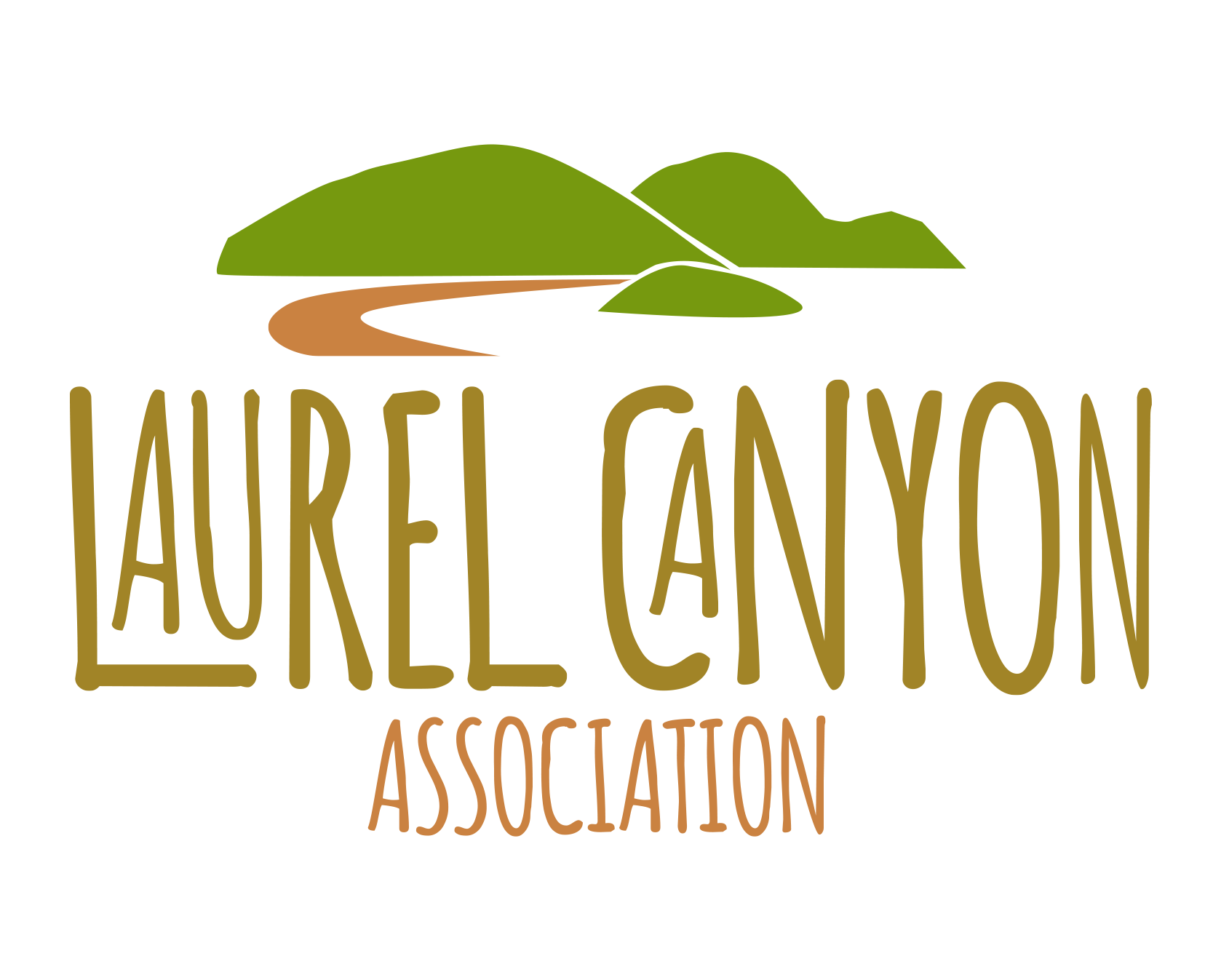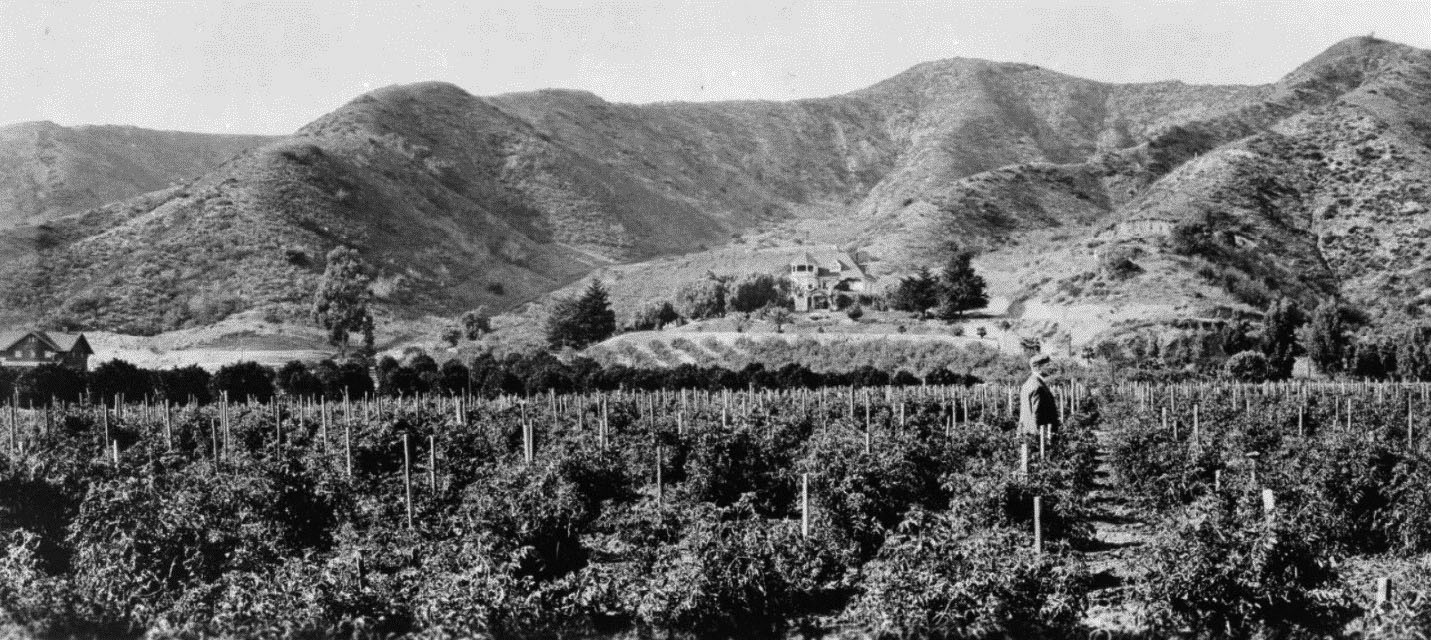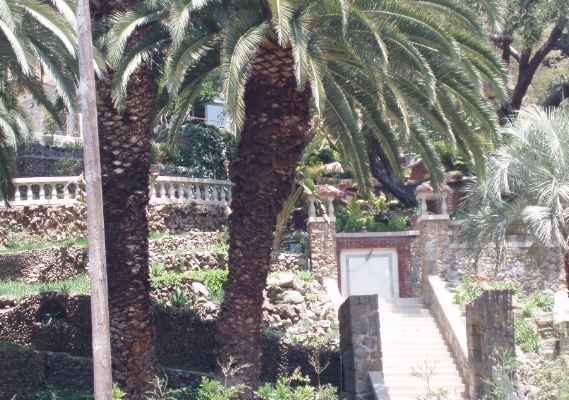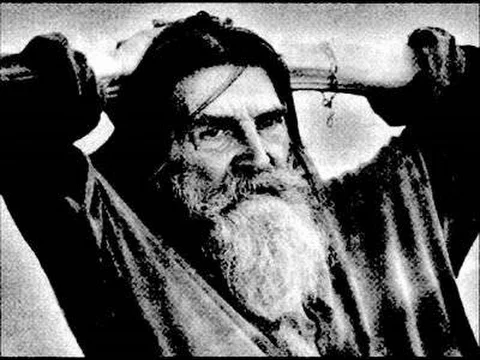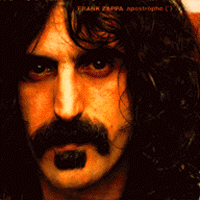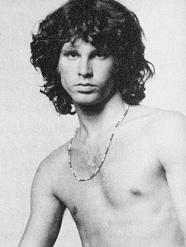Jim Morrison, who lived in a house behind and to the south of the Canyon Store, was one of the many rocks stars who made Laurel Canyon their home in the 60's and 70's.
Part Four: 20th Century Canyon History
Prior to the 1900’s, Laurel Canyon was largely untouched by the forces of change that were occurring in Hollywood and the Valley. All that changed with the area’s massive development spurred by immigration from the east.
Celebrities and Subdivisions
Prior to major development, Laurel Canyon was a secluded valley that supplied water to farms at the base of the canyon and some hillside grazing to sheep ranchers. One of the earliest farming estates was owned by Charles F. Harper, and it dominated the entrance to Laurel Canyon. Harper was a Civil War veteran who immigrated to California and made his fortune in the hardware business. He retired in 1895 and moved to Hollywood, where he "enjoyed the evening of his days" on his 480-acre estate in Laurel Canyon.
As mentioned in the Early Canyon History section, the serious development of the canyon was set in motion by Charles Spencer Mann, an engineer and real estate investor. Mann and his partners bought property along Laurel Canyon Boulevard and up in the hills. Some of the first tracks to be developed in the Lookout Mountain bowl were Bungalow Land and Wonderland Park, both of which were moderately priced with narrow lots and a network of interconnecting lanes and foot paths. This legacy of narrow streets is the reason we have parking and emergency access problems today.
he Harper Ranch at the foot of Laurel Canyon.
As was the custom in these days, restrictive covenants were attached to the new parcel deeds. These were thinly veiled attempts to limit ownership to white males of a certain class. While there are many references to the bigotry of land developers in our area, it would appear that some residents were also prone to bias and lawlessness. This article was published in a local paper in 1925: "Frank Sanceri, the man who was flogged by the self-styled "white knights" on Lookout Mountain in Hollywood several months ago, was found not guilty yesterday by a jury in Superior Judge Shea's courtroom of having unlawfully attacked Astrea Jolley, aged 11."
Wealthier residents were also attracted to Laurel Canyon. With the creation of the Hollywood film industry in 1910, the canyon attracted a host of "photoplayers", including Wally Reid, Tom Mix, Clara Bow, Richard Dix, Norman Kerry, Ramon Navarro, Harry Houdini and Bessie Love. Errol Flynn lived in a huge mansion just north of Houdini's estate. Laurel Canyon was the BelAir of its day, and many of these actor's English Tudor and Spanish style homes can still be seen in the canyon today.
The trackless trolley travelling to Bugalow Land around 1915
An ad for Wonderland Park published in 1924.
The silent film era may have been long ago, but the actors who made Laurel Canyon their home had personal stories that touch our lives today. Ramon Navarro bucked the racial conventions of the day and became the first Hispanic actor in Hollywood. After retiring and in his seventies, he was murdered by burglars in his home, which was on Laurel Canyon Boulevard just past the Canyon Store. Lew Ayres, who was profoundly influenced by his role in All Quiet On The Western Front, became one of the most well-known conscientious objectors during World War II. It all but ruined his acting career; but, when asked to resume his previous film role of Dr. Kildare for television, he insisted that the studio not accept advertising from cigarette companies. The studio refused.
Tom Mix
Bessie Love
Norman Kerry
Lew Ayers
Ramon Navarro
Wallace Reid
Clara Bow was the product of a dysfunctional family in Brooklyn. She came to Hollywood as a teenager and was immediately cast in roles that depicted a strong, sexual woman overcoming adversity and scorn in a male-dominated world. Her acting skills generated great sympathy among American audiences and great profits for her studio employers. Hard partying and scandelous dating temporarily ended her career, but she made a come-back after marrying a Nevada rancher.
Clara Bow, Hollywood's "IT" girl and one of the sexiest actors before imposition of the Code of Decency,
Clara Bow at her home in Laurel Canyon.
The Houdini mansion was the most famous of the several estates built along Laurel Canyon Boulevard. The Houdini mansion burned down in 1958, and the remaining estate is reportedly haunted.
By the time Harry Houdini had moved to Laurel Canyon, he was already a rich and famous celebrity. He had come to California to further his fortune in the Hollywood film industry. In actuality, he had spent little time at his lavish estate on Laurel Canyon Boulevard before he died. His wife, Bess, lived out her days at the estate's guest house, using the mansion to conduct seances with her dead husband.
While more lavish homes were built by Hollywood’s new movie star elite along Laurel Canyon Boulevard and up on the crest of Appian Way, the majority of homes built in the shadows of the canyon were more modest and cabin-like. The properties that were originally bought as vacation home retreats where now being purchased as primary residences. By the 1920’s, it was a proper community with a one-room schoolhouse, a local newspaper, a grocery and several restaurants.
The bucolic, somewhat isolated style of canyon life continued until the 1940’s. In this decade, the canyon was connected to the Valley with an over-mountain highway. Suddenly the canyon was not so isolated anymore. With greater access came still more development, including an odd extension of the movie industry.
In 1947, the Army Air Corps built its top-secret movie production studio on Wonderland Park Avenue. Military training films and Department of Defense documentaries were churned out, including a particularly famous series on the aboveground nuclear tests in Nevada. The studio was deactivated in 1969, and thanks to the efforts of the Laurel Canyon Association, it was prevented from being zoned for further commercial activity.
An illustrated map of Laurel Canyon published by the Canyon Crier, the area's first regularly published newspaper. (click to enlarge) The Crier shared space with Mann Realty at Crier Square at Kirkwood and Laurel Canyon Blvd. Mann Realty is not related to Charles Spencer Mann, the developer.
Lookout Mountain Road was still very country-like in the 1930's, but development continued apace. The cabin below left receives a more substantial neighbor.
The top secret 1352d Motion Picture Squadron (Lookout Mountain Laboratory) hidden in the valley of Wonderland Park Avenue.
The studio created documentaries on Nevada nuclear tests among other projects and is now a unique residence complex
Development began to speed up in the 30's. Laurel Canyon Boulevard was regraded and widened to provide access to the San Fernando Valley.
One of 25 ‘Case Study’ houses commissioned by Arts and Architecture magazine to demonstrate a vision for an efficient and modern Post War housing style.
The Post War Boom
With the end of World War II, another wave of development came. As in previous growth spurts, this phase was driven by a population shift to the Sun Belt and the emergence of new industries, including steel production and aeronautics. The style was definitely modern with many homes built on previously unbuildable lots, including homes built on stilts on steep hillsides – a radical concept for the time. During this period, Arts & Architecture Magazine commissioned the famous ‘Case Study’ houses, and several fine examples survive in the Laurel Canyon area.
The Beat Generation
The Fifties Post-War period also produced The Beat Generation, and Los Angeles supported a lively coffee house and Jazz music culture. One of the poets in this movement and a Laurel Canyon resident was Wulf Zendik (1920-1999). In his A Quest Among The Bewildered, Zendik writes, "Who am I? How can I say, what can I tell you, tell myself -- is there a title I might apply? Let's say the thing I do is light dark corners -- I pick up rotten logs in the dark corner of my mind and look there."
Wulf Zendik
Rock’n Roll Era
In a counterpoint to all this modernism and development, the rustic style of turn-of-the-century Laurel Canyon was rediscovered by musicians during the 60’s and 70’s. Laurel Canyon was second only to Haight-Ashbury as a Mecca for Hippies. This is “where Joni Mitchell was living when she wrote "Ladies Of The Canyons" and "Clouds"; and, Graham Nash wrote "Our House" when he was living here with her. Frank Zappa's infamous home during the sixties was located on the NW corner of Lookout Mountain and Laurel Canyon, where now is a vacant lot. He eventually moved because every nut in town knew where he lived.” Other rock stars included Jim Morrison, John Mayall, Carole King, The Mamas and The Papas, Dusty Springfield, Brian Wilson, and many others. The 2001 film Laurel Canyon is an homage to this legacy.
Laurel Canyon was the physical focal point of the blues-inspired Psychedlic rock movement, and Frank Zappa's rented cabin at Lookout Mountain and Laurel Canyon Boulevard was the center of Laurel Canyon's crazed rock scene. The people who made appearances at the lower cabin that was home to silent film star, Tom Mix, and at the upper Tree House that was designed by famed architect Rober Byrd in the 1920's included, John Mayall, the famed GTO's (Girls Together Outrageously), the "Plaster Casters", Jimi Hendrix, The Doors, Love, Janis Joplin, James Taylor, Mick Jagger, Mary-Ann Faithful, Jeff Beck and many others.
Carol King
Dusty Springfield
John Mayall
Frank Zappa
Brian Wilson
Joni Mitchell
"It was also during this period that frequent cabin-guest Jimi Hendrix briefly resided in the Errol Flynn mansion to the north of the property. The mansion was once a home for "wayward women" and was also occupied in earlier years by notables ranging from Bugsy Siegel to W.C. Fields. The mansion is currently owned by Rick Rubin, co-founder of Def Jam Records and producer of The Red Hot Chili Peppers, Nine Inch Nails, The Black Crowes and numerous others." - Mike Slarve Management.
Jim Morrison
Jim Morrison's house, which was recently remodeled, is next door to the Canyon Cleaners and behind the Country Store.
Of course, with music came drugs. The LAPD's narcotics unit had targeted Laurel Canyon as a special enforcement area, but not before the infamous murders of four drug dealers in 1981 on Wonderland Avenue, just a few houses away from then Governor Jerry Brown's home. The porn star, John Holmes, aka Johnny Wadd, was implicated at first, but then a Palestinian immigrant named Eddie Nash who owned the Kit Kat Club strip joint was arrested and later acquitted. The film Boogie Nights was loosely based on Holmes' life, but the 2003 film Wonderland is based on this shocking event. Holmes later died of complications from AIDS.
Nevertheless, this funky, Rock’nRoll character lives on in the people one sees at the Canyon Store – then and now, “the place where the creatures meet.”
The porn star John Holmes testifying at the trial for the brutal murder of four petty criminals on Wonderland Avenue in 1981. LA Times.
An example of inappropriate development with massive grading and huge retaining walls. Notice how the home on the left is dwarfed by this project.
Gentrification
The years since 1980 have seen a gradual gentrification of the canyon. Older homes have been bought by new residents and remodeled. Our Wonderland School, which is the pride of the community, is packed with the children of a new generation of parents. And, we have a vigorous community group, something we will need in order to preserve the special life style we enjoy here in Laurel Canyon. As with every other place in Southern California, property values have increased. As those values continue to rise, so too the pressure to knock down older homes and develop marginal lots. The result is ever-larger homes that push nature aside.
This is a future we can either accept or control. If the Tongva and their ancestors were able to preserve the land for 40,000 years, certainly we can preserve it for the next generation.
